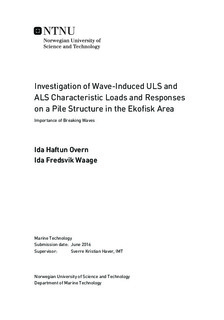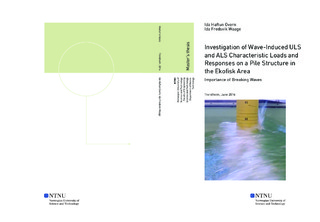| dc.description.abstract | A set of metocean contour lines corresponding to annual exceedance probabilities of 10^(-2) and 10^(-4) describing the environmental conditions at the Ekofisk area are established based on hindcast data. These are divided into different propagation directions as the total sea is composed of considerable waves from north, south and west. For the sake of measuring extreme responses of a slender pile structure, critical sea states selected from these contour lines are subjected for model testing. Wavetrains designed to break at the exact location of the pile are generated in order to investigate the importance of breaking waves relative to the extreme pile responses. A comprehensive investigation of the experimental setup is performed to ensure reliable model test results.
Model tests of critical sea states based on both the JONSWAP wave spectrum and the Donelan wave spectrum are performed for comparable reasons. The Donelan spectrum pro- vides larger crest heights and more severe pile responses than the JONSWAP spectrum for steep sea states. For less steep sea states the opposite trend is seen. Hence, the Donelan spectrum is concluded to be most suitable for steep sea states and the JONSWAP spectrum for less steep sea states in order to obtain the most severe responses.
The critical sea states subjected for model testing are found to consist of smaller wave heights than desired partly due to mechanical losses in the wave maker. This may have led to an underprediction of the characteristic pile responses. In order to account for this in a future extension of this experiment, a correction term amplifying the wave maker motion should be introduced.
Based on the findings from this model test experiment, breaking waves are considered important for global design of the slender pile structure located south in the North Sea. In addition, tremendous impact forces exerted by plunging breakers may lead to local damage of the pile, which in worst case can harm its overall structural strength. | |

